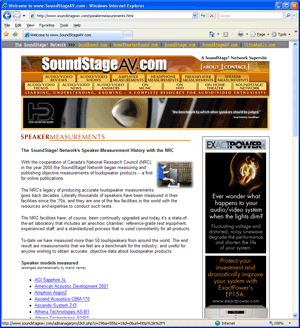 |
| February 1, 2007 High-End Audio's Price/Performance Myth This year’s Consumer Electronics Show was, for me, a more eye-opening experience than usual. As I walked around The Venetian hotel where the majority of the high-end exhibits resided, and listened to similar setups at the T.H.E. Show at the St. Tropez, I was struck by the ridiculously high prices of most of what I heard. There was good value for money in a few rooms, but it seemed that, more often than not, I was sitting or standing in front of a speaker system that cost between $20,000 and $200,000, with sound and/or build quality that seemed worth a fraction of those figures. Most audiophiles who’ve been in this hobby for a few years can remember when $20,000 bought a flagship speaker system -- and speakers that cost that much were rare. These days, $20k hardly gets you up to the middle of many manufacturers’ product hierarchies.The overriding problem I had with most of these products, specifically the speakers, wasn’t their high prices (though that ever-upward trend is disturbing), but what you get for those prices. In many cases the performance -- the sound itself -- didn’t scale with the price. I’m not talking about a linear scale here. We all know that diminishing returns set in at the top end of the curve -- we’ve always paid big money for that last iota of performance. What I’m talking about is performance that in many cases is not as good as what you can get for much less money. As I remarked in my "Daily Diary," part of the SoundStage! Network’s CES coverage, I heard several plus-$50,000 speakers that sounded just dreadful. Now I know that the combination of show conditions and poor room acoustics can be the perfect storm for some speakers, but for the kind of money being asked for these behemoths, I do expect to hear some spark of greatness. But dig deeper into the designs of some of the so-called state-of-the-art contenders and you might be surprised by what you find: subpar engineering, one-off manufacturing, cheap parts, and a lot of bunk that sounds scientific but is really just marketing drivel.
My point is that, when searching for "Sound to the Extreme," as we like to say on Ultra Audio, remember that more money does not always buy better gear. I’ve been sucked into this notion myself at times, but the 2007 CES was perhaps just the dousing with cold water I needed to wake me up. I think it’s imperative to ask more questions, listen more closely, examine claims more thoroughly, and generally be more critical, especially when the asking price is equivalent to a good yearly salary for many people. There are resources out there to help in this process. An example is the "Speaker Measurements" section of SoundStage! A/V. Measurements will help to show you whether a design stands up to objective tests, and if the manufacturer’s claims of a product’s technical performance are true. But always ask this: Are you really getting what you’ve paid for? In my opinion, in some cases the answer will be Yes, but in many cases it will be No. More performance is what I’m after. Since it’s become painfully obvious that more money won’t always buy that, the search, as far as I’m concerned, must become more rigorous, and our standards must be set higher. ...Jeff Fritz
Ultra Audio is part of the SoundStage! Network. |
 This begs the question: When
the price of a pair of speakers runs into five figures, what should you expect from them?
First, performance that equates in some way with that price. The speakers should sound
simply extraordinary -- plain and simple, no apologies. Second, the speakers should be
based on first-class engineering backed up by a rigorous measurement process that proves
the product’s soundness of design. This is simply a fail-safe check for what
you’re hearing. Third, the manufacturer should be a solid company on firm financial
footing and with outstanding customer service, so that your investment is protected. And
fourth, the build quality should be good enough to guarantee that your purchase will last
for many years to come.
This begs the question: When
the price of a pair of speakers runs into five figures, what should you expect from them?
First, performance that equates in some way with that price. The speakers should sound
simply extraordinary -- plain and simple, no apologies. Second, the speakers should be
based on first-class engineering backed up by a rigorous measurement process that proves
the product’s soundness of design. This is simply a fail-safe check for what
you’re hearing. Third, the manufacturer should be a solid company on firm financial
footing and with outstanding customer service, so that your investment is protected. And
fourth, the build quality should be good enough to guarantee that your purchase will last
for many years to come.